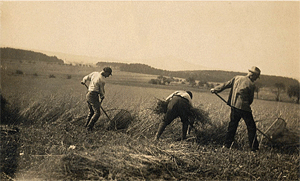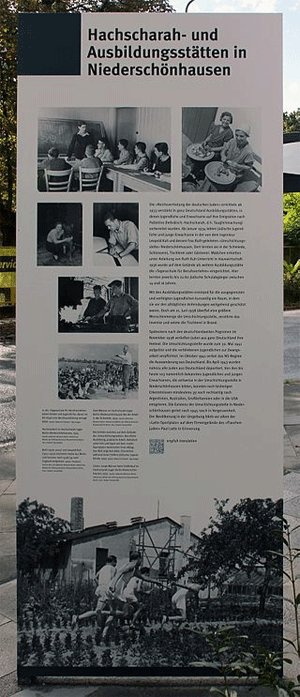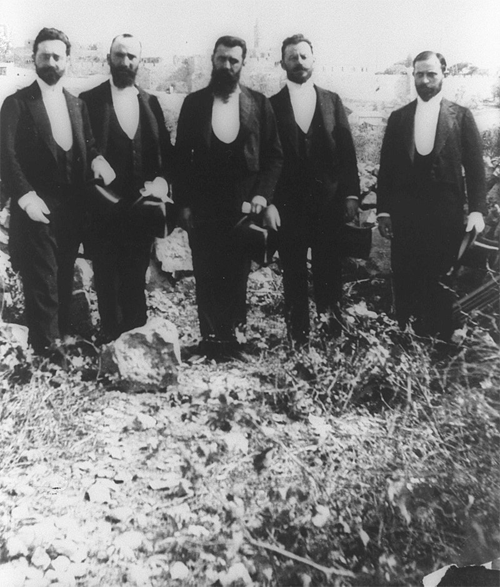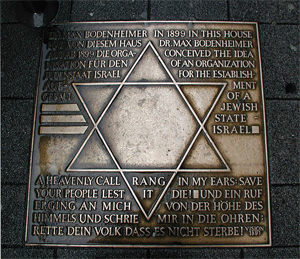by Wikipedia
Accessed: 11/14/18
NOTICE: THIS WORK MAY BE PROTECTED BY COPYRIGHT
YOU ARE REQUIRED TO READ THE COPYRIGHT NOTICE AT THIS LINK BEFORE YOU READ THE FOLLOWING WORK, THAT IS AVAILABLE SOLELY FOR PRIVATE STUDY, SCHOLARSHIP OR RESEARCH PURSUANT TO 17 U.S.C. SECTION 107 AND 108. IN THE EVENT THAT THE LIBRARY DETERMINES THAT UNLAWFUL COPYING OF THIS WORK HAS OCCURRED, THE LIBRARY HAS THE RIGHT TO BLOCK THE I.P. ADDRESS AT WHICH THE UNLAWFUL COPYING APPEARED TO HAVE OCCURRED. THANK YOU FOR RESPECTING THE RIGHTS OF COPYRIGHT OWNERS.
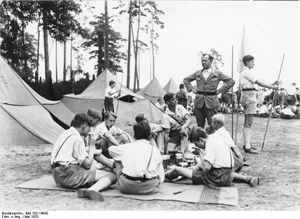
Camp of the Bündnis Jugend in Berlin-Grunewald (1933)
Bündische Jugend is the term used to describe the youth movement that emerged from Wandervogel in Germany in its second phase after the First World War . Building on the ideas of migratory birds and scouts, the fraternities of the League of Bishops came into being in the Weimar Republic (called the Bündnis for short).
History
Both scouts and hikers returned from World War I disillusioned, in addition, much of the previous leaders had fallen. As a result, the frets and the covenant landscape changed. They wanted to change society from the ground up. Political activities began to gain importance.
During this time, the youthful youth cultivated a human image of the man as a knight , who voluntarily subjects himself to the discipline and self-discipline that is at the service of his covenant and its goals. Important for the formation of the Bündnis Jugend was the endeavor to form groups in the future, which should not exist as formerly in Wandervogel only from young people, but had the character of a Lebensbundes. Many fraternities, the aspired federal community appeared only in pure male or female alliances, which is why co-operative fraternities greatly lost importance.
From 1924 propagated some frets, z. For example, the Silesian Young Team (SJ) and the Artamans , the labor camp as an educational tool in which the national community should be brought to life. After F. Raabe they wanted to prepare the development of the people's race; In this way, they were to rearrange the state and society from the point of view of the Volkstum and thus ensure the organic cooperation of all parts across all classes, parties and denominations.
In 1927, the German Freischar formed as a central alliance of various fraternities of the Scout and Wandervogel movement.
The Catholic Youth Association Bund Neudeutschland , in which Catholic students were organized in secondary schools, can be counted among the Bündische Jugend.
Around 1930, the boyhood movement came on, which rejected the Lebensbundprinzip and put in its place the idea of self-education of the younger. The boyhoods exerted a great fascination on the groups of the Covenant Youth. Most frets were challenged in a central question of their self-image. Although some style elements such as Kohte and boy jacket were gradually taken over by most frets, the existing frets were largely able to assert themselves.
In 1933, many frets in the Greater German Confederation, led by Admiral von Trotha, joined forces, hoping not to be banned by the NS state as a larger federation of some 50,000 members. A common Bundestag was planned as a federal camp at Pentecost in Dresden on the site training place Heller , but temporarily prohibited by the NS Reichsstatthalter Mutschmann . Therefore, the federal dodged on Munster , where he was also supported by the Reichswehr . The event was considered a provocation by the Hitler Youth . As a result, ordered the district administrator of the district Fallingbostelon Pentecost Sunday (4 June) the immediate demolition of the camp. [1] A few weeks later, the big German Bund was prohibited. [2]
From 1933, the Hitler Youth , which had initially oriented itself to the forms of the workers' youth movement , took over part of the scouting and bourgeois traditions. This led many of the members of the Bündische Jugend to hope to transform the Hitler Youth from the inside out in a literal sense. Therefore, a part of the frets voluntarily joined the Hitler Youth, while other groups disbanded themselves to escape incorporation. From the summer of 1933, the frets were initially banned in the Third Reich , later were also appropriate clothing and equipment under the name of civil machinations as punishable. The free frets were considered "archenemies of the Hitler Youth" (quote Baldur von Schirach ). The suppression of the structures of the bourgeoisie initially met with incomprehension and rejection in regime-milieu milieus and partly also in party offices and state organs. National Socialist ideologues therefore carried out intensive negative labeling and criminalization of the youth leagues. Often one resorted to the discrediting of the structures of the bourgeoisie to the actually given or simply assumed homosexual orientation of the Bündnis.[3]
Since the structure of the League groups was not designed for illegality, a significant portion adapted to the total state as necessary to survive, or went into exile early, especially to Britain. [4] A small group of units continued in secret, continuing their underground journeys and camps. These groups went through a politicization due to the Nazi persecution. [3] They formed part resistance groups against the Third Reich and led partially open street battles against the HJ. This resistance was felt especially in the Rhineland . Many of theseWild League youth groups were called Edelweiss Pirates or called themselves by the name under which they were persecuted. To popularize this youthful subculture contributed that the free youth groups realized those claims and expectations that propagated by the Hitler Youth, but ultimately were not met, especially the continuation of the youth movement and self-determination within the youth groups. In addition, the oppositional youth milieu formed an attractive contrast to the regulated HJ system for many adolescents through the free roaming and traveling life with romanticizing customs and free intercourse between the sexes. [5]
After the beginning of the Second World War , many of the Bundische living in British exile took part in the preparations of the Socialist Union of the SPD , ISK and the "re-starting" group led by Richard Löwenthal for the democratic reconstruction of Germany after the war. [6]
Basic Beliefs
The development of the youth movement from Wandervogel to the Bündische Jugend brought about a change in the basic convictions:
While the Wandervogel emphasized the renewal of the individual and derived other innovations from it, the Bündnis Jugend immediately sought the renewal of society. [7] [8]
Like the wandering bird, the Covenant Youth was no longer an end in itself, which in itself was revolutionary. Instead, the individual through the admission into the covenant carried out a comprehensive "service obligation", which claimed him to the most private. [8th]
They paid homage to religious ideas and took the order of knights as their model. The individual was not his group leader, but all were committed to the common cause.
The orientation towards the Bündisch led in part to the fact that the Bund understood as a boys and men alliance "par excellence" (Laqueur), which led to a significant decrease coeducational and to a segregation of female groups. [8th]
There was an elitist claim. It was aimed at a selection: By far not every aspirant was included in a covenant. Often, boys were selected who could fit into the respective covenant, and only these were asked if they wanted to see a group of the federal once. The idea of the covenant thus also lived from the opposite to the mass. [9]
Externally, the emergence of a unified gap was an expression of the close community of the Federation or Order of importance.
The Covenant Youth emphasized symbolic acts and romantic, solemn and mythical forms. This was closely related to the examination of the common sense, partly through his engagement with the poet Stefan George : his federal concept, which he described in 1914 in the Star of the Covenant , had a mythical-religious character. [10] George could not enthusiastic about the reformist ideas of the Wandervogel themselves. [11]
Another idea generator of the Bündnis Jugend came from Great Britain. John Hargrave developed his ideas in the British Scout movement. From this Hargrave was expelled in 1920, whereupon he founded the movement Kibbo Kift the Woodcraft Kindred . In Germany, the natural educational principles developed therein were received with great interest. [12]
As in other branches of world history, the idea of a covenant of life was part of the basic ideas of the Bündnis Jugend. This was in marked contrast to the basic beliefs of the Wandervogel of the time before the First World War.
Review by historian
After the end of the Third Reich, critics of the Bündische Jugend claimed to have been stirrup-holders of National Socialism by conveying similar ideas such as "leading and following", "soldierly virtues" or patriotism. Others pointed out that the frets placed great value on self-determination and autonomy , emphasized the personal relationship between leaders and leaders, that their elitist claims did not fit with the mass movement of National Socialism and that they were unpolitical.
"To sum up: The bourgeois German youth movement until 1933 was in its political way of thinking or emotional world mostly so far in the vicinity of National Socialism that they 1933 as part of the" national survey "could understand. These political ideas of the youth movement and its majority were signs of a general political maldevelopment of the German bourgeoisie - but only a symptom, in addition to many rectified and certainly not the cause of the movement towards fascism. But when fascism was state-established in Germany, it became apparent that in the tradition of the youth movement there was at the same time a chance of a system -oppositional behavior.
- Arno Klönne . [13]
Present
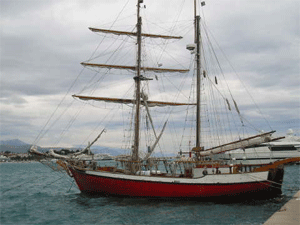
Brigantine Falado of Rhodes, sailed by allied youth groups . The ship sank on August 9, 2013.
It is disputed by historians to what extent the Bündische Jugend persists today. Some believe that it finally went under with the beginning of the National Socialist dictatorship . They justify this with the great differences in the worlds of life of young people and the frequent structural and substantive reorientation of the reunited after the Second World War frets.
Unaffected by this there are today groups and fraternities, which consider themselves to be both culturally and / or youth-motivated. Numerous youth movements / covenants have re-established their league after the end of the Third Reich, following the tradition of the 1920s and early 1930s. In addition, there are occasionally new start-ups of groupings. More common, however, is the elimination of parts of a group because of incompatibility of beliefs.
Also groups of the German scouting movement and the church youth work, especially of the YMCA , are influenced by the influences of the youth movement, which distinguishes them also internationally. However, there are big differences between the individual groups.
Mannheim Resolution
As Mannheim resolution is a display of many frets of the youth movement in the weekly newspaper The time of January 15, 1993 called. In it, the signatories spoke out against the xenophobic riots in the fall of 1992. The resolution was signed by a large number of groups and individuals who follow the Bündnis Jugend and has also been published in several daily newspapers. [14]
Covenant Initiatives and Groups
• Castle Balduinstein
• Castle Ludwigstein
• Waldeck Castle
• Jugendburg Streitwiesen
• Brigantine Falado of Rhodes eV with the sailing schooner Whydah of Bristol
• the icebreaker , supra-first journal
• Ring of young frets
• Nerother hiking bird
• German Freischar
• Migratory bird - German travel federation
• German forest youth
• various hiking bird groups
• different boyhood groups
• different scout groups
• YMCA West Union ecumenical associations of Protestant confession with numerous small local youth groups [15]
Literature
• Rüdiger Ahrens: Covenant Youth. A new story 1918-1933. Wallstein, Göttingen 2015, ISBN 978-3-8353-1758-1 .
• Matthias von Hellfeld : Covenant Youth and Hitler Youth - The History of Adaptation and Resistance 1930-1939 . Publisher Science and Politics, 1987, ISBN 3-8046-8683-4 .
• Werner Kindt: Documentation of the Youth Movement, Volume III: The German Youth Movement 1920 to 1933. The Covenant Time . Diederichs, Dusseldorf 1974, ISBN 3-424-00527-4 .
• Arno Klönne : Youth opposition in the "Third Reich" . National Center for Political Education Thuringia. Second edition, Erfurt 2013 ( PDF ).
• Arno Klönne: Youth in the Third Reich: The Hitler Youth and their opponents . Papy Rossa Verlag, Cologne 2003, ISBN 3-89438-261-9 .
• Walter Laqueur : The German Youth Movement . Publisher Science and Politics, Cologne 1978, ISBN 3-8046-8548-X . Translation by: Walter Laqueur: Young Germany: A History of the German Youth Movement , Transaction Pub, 1984, ISBN 0878559604 .
• Florian Malzacher , Matthias Daenschel: Youth movement for beginners. 2nd Edition. Verlag der Jugendbewegung, Stuttgart 2004, ISBN 3-88258-131-X .
• Felix Raabe: The League of Youth. A contribution to the history of the Weimar Republic . Brentanoverlag, Stuttgart 1961.
• Alexei Stachovich in: Bündisch ist ... Contributions to the question of the Bündnis . Publisher: Free educational work Balduinstein, Burg Balduinstein 1977.
Web links
• Bündisch ist ... Definition attempts
• What is bündisch? Another attempt at definition
• Youth in Germany 1918 to 1945: Bündische Jugend (NS Documentation Center of the City of Cologne)
Bündische Gruppen
• http://www.wandervogel.de Portal to different Wandervogel bands
• http://www.cvjm-buendisch.de Bündische Jugendarbeit in the CVJM -Westbund
Overbundling Initiatives [ edit | Edit ]
• Bishops Academy
• Falado of Rhodes, carrier association
• Culture initiative
• Sound Archive of the Covenant Youth
Individual proofs
1. Joachim von Stülpnagel: "Munster Camp" Pentecost 1933 - last big event of the Bündnis Jugend. In: 100 years soldiers in Munster 1893-1993. Publisher: Stadt Munster, August 1993, p. 86 f.
2. Hellfeld, p. 90ff.
3. Arno Klönne: Youth Subcultures in the Third Reich. In: shock and creation - youth aesthetics in the 20th century. Darmstadt 1986, p. 311.
4. Borinski, Grimm, Winkler, Wolf (ed.): Youth in Political Protest 1923-1933-1977 (Sources and Contributions to the History of the Youth Movement, Vol. 19). Frankfurt am Main 1977, p. 81 ff.
5. Arno Klönne: Youth Subcultures in the Third Reich. In: shock and creation - youth aesthetics in the 20th century. Darmstadt 1986, p. 312.
6. Borinski, Grimm, Winkler, Wolf (ed.): Youth in Political Protest 1923-1933-1977 (Sources and Contributions to the History of the Youth Movement, Vol. 19). Frankfurt am Main 1977, p. 88.
7. Peter Nasarski : Awakening of youth in the border and abroad. In: ders .: German Youth Movement in Europe. Cologne 1967, p. 21.
8. Walter Laqueur : The German Youth Movement. A historical study. Cologne 1962, p. 150.
9. Wolfgang Lindner: Youth movement as an expression of ideological mentality. The mentality-historical preferences of the German youth movement in the mirror of their lyrics. Schriften zur Kulturwissenschaft 48. Hamburg 2003, ISBN 3-8300-0886-4 , p. 312f.
10. Florian Malzacher, Matthias Daenschel: Youth movement for beginners. 2nd Edition. Südmarkverlag Michael Fritz KG, Stuttgart 2004, ISBN 3-88258-131-X , p. 68ff .; Wolfgang Lindner: Youth movement as an expression of ideological mentality. The mentality-historical preferences of the German youth movement in the mirror of their lyrics (Schriften zur Kulturwissenschaft 48). Hamburg 2003, ISBN 978-3-8300-0886-6 , p. 312f .; Walter Laqueur : The German Youth Movement. A historical study. Cologne 1962, p. 151f .; Johann Thun: The Bund and the frets. Stefan George and the German youth movement, In: Thorsten Carstensen, Marcel Schmidt (Hrsg.): The literature of the Lebensreform. Transcript, Berlin 2016, ISBN 978-3-8376-3334-4 , pp. 87-105.
11. Thomas Karlauf: Stefan George. Pantheon, 2008, p. 397.
12. Walter Laqueur: The German Youth Movement. A historical study. Cologne 1962, p. 153f.
13. Arno Klönne : Youth in the Third Reich. The Hitler Youth and their opponents. Papyrossa Verlagsges., 2003, ISBN 3894382619 , p. 125.
14. Mannheimer Resolution
15. Bündische Arbeit CVJM Westbund

